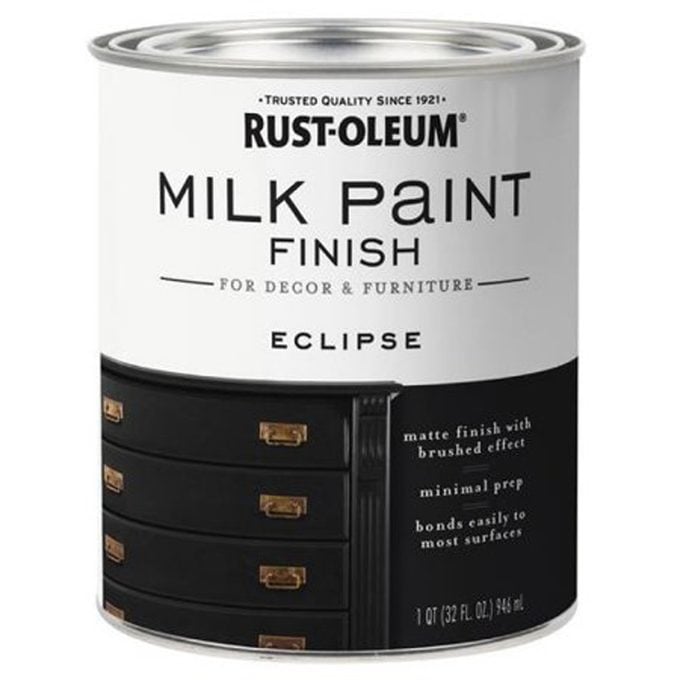What is Milk Paint and Should You Be Using It?
Updated: Aug. 20, 2023
If you're looking for that naturally rustic look, milk paint is your best bet.

As a DIY enthusiast, you know a thing or two about paint, but when you get to the hardware store’s paint section, you may stumble across a type you’ve never heard of before.
On This Page
What is Milk Paint?
Milk paint isn’t a new invention. Tracing its roots back to ancient civilizations, evidence of milk paint has been discovered in age-old pyramids and even in cave paintings. This historic paint is often found on antiques that still bear their original coats. The charm of milk paint lies in its composition. Made up of non-toxic ingredients such as milk protein, clay, and lime, milk paint stands out from its contemporaries due to its absence of VOCs (volatile organic compounds). These solvents, present in many modern paints, release into the air as the paint dries and can cause unpleasant symptoms like dizziness and headaches.
Environmental and Health Benefits
One of the significant advantages of milk paint is its eco-friendliness. Unlike most conventional paints that are laden with chemicals, milk paint offers a greener alternative that’s also better for your health. Its natural ingredients ensure that there are no harmful fumes or odors upon application.
Application and Longevity
For those wondering about the practicality of using milk paint, its application is a dream. Unlike many other paints, there’s no need for sanding or priming the surface in preparation. It adheres well to a multitude of surfaces, including wood, metal, glass, masonry, plastic, drywall, and plaster. One unique aspect of milk paint is its storage form; it’s sold in a powdered format. This is because, once mixed, the paint becomes perishable. However, in its powdered state, it boasts an indefinite shelf life, perfect for DIYers who don’t paint regularly. To activate the paint, mix the powder with water. A heads-up: the mixture has a lifespan of about a week, so only prepare what you’ll use in the short term.
Finish and Aesthetics
Milk paint promises DIYers a finish that’s distinct and versatile. If applied with a binder, it yields a soft, matte appearance. But if you’re aiming for that genuine, rustic look, applying it in its natural state will achieve that effect. Moreover, milk paint dries remarkably quickly, often in just 30 minutes or less.
Can you DIY Milk Paint?
Making your own milk paint at home is feasible and allows you to customize the paint to your desired shade. Homemade milk paint is eco-friendly and offers the same rustic, matte finish as store-bought versions. Here’s a basic recipe to get you started:
DIY Milk Paint Recipe:
Ingredients:
- 1 cup of skim milk (full fat can be used, but skim milk tends to produce better results)
- 1 tablespoon of white vinegar or lemon juice (to curdle the milk)
- 1-2 tablespoons of hydrated lime (available at hardware stores or online)
- Natural pigment or food coloring for desired color
- A sieve or cheesecloth
Instructions:
- Curdling the Milk: In a bowl, combine the skim milk with white vinegar or lemon juice. Let the mixture sit for a few hours (typically 1-2 hours) until the milk separates into curds and whey.
- Separating the Curds: Once the milk has fully separated, use a sieve or cheesecloth to strain out the curds. You’ll use these curds for your paint base.
- Creating the Paint Base: In a separate bowl, slowly add the hydrated lime to the curds, mixing continuously to form a smooth paste. Ensure the mixture is lump-free.
- Coloring: Add your choice of natural pigment or food coloring to the paste. Add little by little, stirring well until you achieve the desired shade.
- Application: Like commercial milk paint, DIY milk paint can be applied to a variety of surfaces including wood, drywall, and plaster. It dries quickly, so you’ll want to use it soon after making it. Also, remember that homemade milk paint can spoil, so it’s best to make it in small batches and use it immediately.
- Storage: If you’ve made extra, you can store your milk paint in the refrigerator for a day or two. Check for any signs of spoilage (e.g., mold or a sour smell) before using stored paint.
Tips:
- Hydrated lime can be caustic, so make sure to wear gloves when handling it to avoid skin irritation.
- Test your paint on a small, inconspicuous area first to ensure you’re happy with the color and finish.
- The consistency can be adjusted with a little water if the paint is too thick, but remember that milk paint is typically thinner than commercial paints.
Conclusion
For those who cherish a touch of the past or simply want an environmentally-responsible paint option, milk paint is an ideal choice. Its ease of application, coupled with its green credentials, makes it a paint that not only beautifies your space but also respects the environment. Whether you’re a seasoned DIYer or an occasional painter, milk paint’s forgiving nature and unique characteristics will certainly pique your interest.
Photo: Courtesy of Rust-Oleum



















